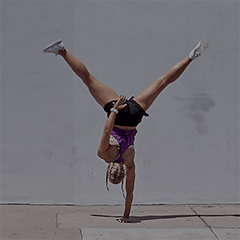High-intensity interval training (HIIT) has made its name as a fitness game-changer, and there are plenty of studies highlighting its remarkably transformative effects. The results come from going as hard as you can for a short period of time, resting, and then repeating. It’s a formula that allows you to keep reaching your maximum training zone again and again, shocking your body each and every workout.
But you can have too much of a good thing. Ground-breaking new research highlights how adding volume doesn’t necessarily deliver better results.
For the most part, the stress HIIT puts your body under is beneficial – as it’s this stress that drives change. But your body is only able to handle a certain amount of stress at once. Jinger Gottschall, Associate Professor at Pennsylvania State University and study author, elaborates:
“When your body is introduced to a stressful scenario, such as high-intensity exercise, stress hormones like cortisol are released. The effects of cortisol can be positive; enhanced strength, improved immunity, and reduced inflammation. But we have long suspected that too much high-intensity exercise can compromise this effect.
Short term increases in cortisol help the body repair, adapt and grow stronger. Long term increases in cortisol can cause fatigue, joint pain and mood disturbance.
Adequate recovery is key
There are many factors that make HIIT so effective, including pushing your heart rate into a specific training zone; impact forces greater than ten times your body weight; and performing exercises until failure. Because of these extreme characteristics, says Gottschall, it is imperative to adequately recover between sessions.
“The recovery period is when all the positive adaptions and developments take place and insufficient recovery can reduce your training’s effectiveness,” says Gottschall. In fact, it can actually have a negative impact. Despite feeling as though you’re pushing your body to maximum performance, you won’t be getting a good return on your hard work, and you may be doing more harm than good.

So how much HIIT should you be doing?
Gottschall has evaluated the heart rate profiles from thousands of athletes in the last 20 years and completed three different studies using Les Mills’ HIIT programming. Based on this she hypothesized that approximately 40-50 minutes of intensity above 85 percent max per week is optimal to allow for proper recovery and ideal performance. This newest study backs up this recommendation, and narrows in on the range to show that 30-40 minutes above 90 percent maximum per week is the recommended total.
Research shows that 30-40 minutes of training with your heart rate above 90 percent is a suggested maximum cumulative time per week, in order to prevent symptoms of overreaching.
The study involved 35 healthy adults who regularly exercised for more than eight hours a week. The participants completed their typical training for three weeks while wearing a Polar A370 watch (with H10 chest strap), recorded their nutrition and completed surveys on mood. The results show a correlation between weekly time spent training at an intensity greater than 90 percent maximum heart rate and the symptoms of overreaching.
SYMPTOMS OF FUNCTIONAL OVERREACHING
- A plateau or drop in training progress
- An increase in musculoskeletal injuries
- Increased frequency of illness
- Feeling exhausted, rather than energized, after exercise
- Disrupted sleep
- Moodiness, a short fuse, or depression
The winning formula: the best way to feature HIIT in your exercise regime
The first thing to remember is that HIIT is not for everyone. Gottschall recommends that you only introduce HIIT after at least six months of consistent exercise, doing a mix of cardio and resistance training across five days a week. “At this point you can replace one cardio session with one or two shorter HIIT sessions, separated by two sleep cycles.”
She also recommends a regime combining moderate-intensity cardio with HIIT, strength and core training. “This provides a combination of stimuli that will train all the varying energy systems, motor units, and muscle fiber types – and that’s what drives real results.”
Limit the time you spend with your heart rate above 90 percent maximum to 30-40 minutes per week and balance it with other, less demanding, workouts.
How much HIIT you do should depend on how much time you dedicate to exercise each week.
Recreational exercisers seeking enjoyment and good health
- 2x cardio workouts (30-45 mins)
- 1x strength workout
- 1x flexibility workout
- 30 minutes of HIIT
Intermediate exercisers keen to improve fitness
- 3x cardio workouts (30-45 mins)
- 2x strength workouts
- 1x flexibility workout
- 60 minutes of HIIT (which should drive you to train at 90 percent of your maximum heart for 30-40 minutes)
Advanced exercisers seeking elite fitness
- 4x cardio workouts (30-60 mins)
- 2x strength workouts
- 1x core workout
- 60 minutes of HIIT (which should drive you to train at 90 percent of your maximum heart for 30-40 minutes)
If you’re serious about maximizing the benefits of HIIT use a heart rate monitor, such as the (Polar A370 with H10 chest transmitter) to track your heart rate and ensure you don’t exceed time in the 90 percent maximum zone for more than 40 minutes in a week.
You can easily establish your own max heart rate by deducting your age from 220. So, if you’re 28, your approximate max heart rate will be 192 (and you will reach the 90 percent maximum zone when your heart rate hits 173).
Should you do a weekly dose of HIIT all at once?
For many, a 30-minute HIIT workout is the ideal session length. Workouts such as LES MILLS GRIT™ are carefully crafted so that your heart rate reaches specific training zones for a certain proportion of the workout, which means your heart rate is likely to reach 90 percent maximum for a period of 15 minutes. This means that with two LES MILLS GRIT workouts a week you can reach the optimum weekly dose of HIIT.
But workout length really is flexible. As long as you follow the formula of extreme intensity followed by rest you can enjoy the benefits of HIIT in much shorter sessions – you can read more about remarkably short HIIT sessions here.
What happens if you do HIIT workouts more often but simply lower the intensity?
If you want the transformative effects of HIIT, intensity is imperative – basically, you need to go hard! It doesn’t make sense to do more HIIT workouts at a lower intensity, as dropping the intensity can mean your training shifts into the vigorous-intensity interval-based training category (which is often defined as 70-85 percent maximum heart rate) or even the moderate-intensity cardio space. Consequently, you don’t get the same transformative benefits of a true HIIT workout.
However, Gottschall says the value of moderate-intensity cardio should not be overlooked. “Moderate-intensity cardio can be performed for longer periods of time and thereby train endurance systems,” Gottschall stresses. “This intensity has been tested in countless studies and provides multiple benefits in terms of cardiovascular health, cholesterol levels, triglycerides, and fasting glucose.”
“Basically, if you’re not doing some moderate-intensity cardio your body is missing out,” says Les Mills Head of Research, Bryce Hastings.
"While short, sharp HIIT workouts are great, you need to ask yourself what your body is doing in the long periods between workouts. It’s no good exhausting yourself with HIIT and then sitting on the sofa – you still need to be active throughout the day, and on rest days, to fully benefit your body.”
Listen to Professor Gottschall discuss the research here:
This audio content is published under licence and in partnership with Radio New Zealand, one of the world’s foremost public broadcasters.








